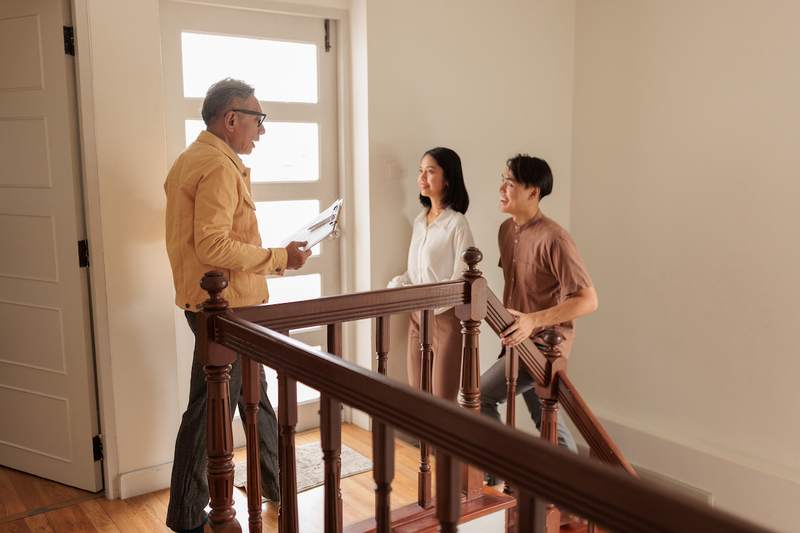While you can buy a house without ever viewing it in person, most buyers choose to go on a home tour before making an offer. The tour gives you a chance to closely assess the place you might decide to call home. As you look around, it’s helpful to know what to keep an eye out for.
Key Takeaways:
- When touring a home, check the square footage, the floor plan, and for any structural issues. Also make sure to ask plenty of questions to get a better understanding of the property.
- Examine any systems that need to be replaced so you aren’t stuck with expensive repairs or home improvement bills after closing on the house.
- Knowing what not to look for on a house tour is just as important. For example, staging shouldn’t play a big role in your decision to buy the property.
What To Look For On a House Tour
Going on a house tour is often an exciting part of the homebuying process, but you should also use the tour as an opportunity to assess the details of the property. Let’s explore exactly what to look for when touring a house.
Square footage
Consider having your real estate agent double-check the home’s square footage to confirm it matches the listing. Square footage is the amount of livable space you’ll have. The right amount of space varies from buyer to buyer, but the median size of a new single-family home sold in 2021 was 2,356 square feet.
Also, ask whether the basement is included in the square footage. If it’s not, there could be an opportunity for a future renovation or home improvement to create additional square footage.
Floor plan
Some people prefer an open floor plan, while others prefer separation between common areas. During the house tour, try to envision yourself using the space. If something doesn’t feel comfortable, then it might not be the right home for you.
Kitchen, bathrooms, and bedrooms
The number of bedrooms and bathrooms is a core requirement for most buyers. After all, you want to have enough bedrooms and bathrooms for your personal situation, whether you’re accommodating a growing family or sharing the space with roommates.
While many make do with a single bathroom, other buyers prefer multiple bathrooms. On some house tours, you’ll come across a half bathroom, which often includes just a toilet and sink. Depending on the location of the other bathrooms, a half bath could add convenience for your family and guests.
Also, confirm that the kitchen is functional for your needs.
Storage space
As you tour the home, check out your storage options, and think about how you might fit all your items into the space. For example, you might want a walk-in closet to hold your clothing collection, or a pantry near the kitchen area if you’re an avid baker.
Without enough space, it’s easy for a home to feel cluttered. If the home doesn’t have enough storage, it could be a deal breaker.
Unpermitted additions
An unpermitted addition might not appear on the listing. For example, you could show up to a house tour and find out there’s an extra bedroom or bathroom.
Common unpermitted additions include converted garages or basements. Unpermitted additions can be dangerous in some cases, and they are often a hassle to deal with. The city may require you to pay fines to get the work permitted, or require you to take down the conversion.
Make sure to ask the seller whether the extra space is permitted or not.
Structural issues
If you buy a home with structural issues, you could end up footing the bill for expensive repairs down the line. While a home inspection may be required to uncover these issues, you can keep an eye out for telltale signs.
Wall and floor condition
As you walk through the space, look for warped floors, cracks in the walls, rotting wood, or anything else that could be more than just cosmetic damage. Major cracks in the floors or walls might indicate a problem with the foundation, and warrant a closer look.
Water damage
Some signs of water damage include bubbling on the walls, peeling paint, a buckling floor, and damp odors. If you spot water damage, try to find the source. Common places to look include the roof, burst pipes, and leaking appliances.
Water damage can be a red flag because it could lead to long-term problems that are expensive to fix. You don’t want to get stuck with a home that has unresolved leaks.
Roof condition
Checking the condition of the roof can help you avoid getting stuck with a home that needs costly repairs.
“A lot of people forget to check the condition of the roof when touring a house,” says Alex Capozzolo, co-founder of SD House Guys in San Diego. “Look for any signs of wear and tear, such as missing shingles or water damage.”
A bad roof could cost you thousands of dollars. The normal cost to replace a roof ranges from $5,725 to $12,401.
Systems That Need To Be Replaced
Every home has systems that need to be replaced eventually. Here are different systems to examine on a house tour.
Gas pipes
Start by turning on a gas appliance, like a stove, to check how well it works. If the appliance is slow to start, there could be an underlying issue. A damaged pipe can lead to a gas leak.
If you notice the smell of gas anywhere, it’s important to bring in a professional to take a closer look. A qualified inspector will be able to determine whether there’s a real issue.
Water pipes
Turn on the tap when you’re touring the home. If you spot orange or brown water, the water pipes could have a rust issue.
Also, check out the water pressure. If a trickle comes out, it might indicate a leak diverting the water along the line.
Electrical wiring
Bad wiring isn’t just an expensive repair — it’s also a safety hazard. Arrive prepared with something to test the outlets, such as a voltage tester, to confirm that the sockets work.
Also, test out all the light switches in the home. If a light is flickering, it could indicate faulty wiring.
Fence and yard
You’ll need to evaluate the entire property, not just the home’s interior, to get a full look at what you might be signing up for.
If there’s a fence, take note of its condition. Factor any potential repair costs into your assessment of the property.
If there isn’t a fence, find out if you have the option to put one up. Some homeowners associations and cities don’t allow fences for certain properties, so it’s best to know the answer before making an offer.
Sprinkler system
If you don’t envision yourself watering the garden, find out whether the property has a sprinkler system. If it does, check the integrity of the system by asking the current homeowner to turn it on for a few minutes. You’ll likely notice any major problems right away based on how the water comes out.
Sewer line
A broken sewer line can create a smelly problem. If you notice an odor in the yard or distinct wet spots, it might indicate an underlying sewer issue. Ask for more information about the sewer line, and possibly an inspection, before moving forward.
Other Important Things To Look For
While we’ve covered the major points, there are some other things to look for when touring a house.
Odors
Unwanted smells, like cigarette smoke or pet odors, could put a damper on your living experience. In the worst case, a musty odor might be a sign of mildew or mold, which can lead to serious health problems.
At some open houses, the seller or their agent might use candles or incense to try masking any unwanted smells, so make sure to pay close attention.
Age of the home
A home’s age can help you determine if there are certain safety issues to consider. For example, an older home might require extensive work to get its electrical and plumbing systems up to code. Other issues could include asbestos insulation and lead paint on the walls. While the previous owner might have made updates, take a closer look if the home was built before the 1980s.
Vulnerability to natural hazards
Natural hazards can wreak havoc on your future home. Take stock of any leaning or unhealthy trees surrounding the house. Also, check out the slope of the land. In some cases, hills can funnel water toward homes after heavy rain.
Neighborhood
Looking beyond the property, consider the neighborhood. It’s helpful to come by the home at different times of the day to get a better feel for the neighborhood. You’ll also want to confirm that the other homeowners in the area are maintaining the appearance of their property.
What Not To Look For on a House Tour
Now you know what to look for during a house viewing. But what about the things you should ignore?
Staging
Staging can help you visualize how you might decorate the space — but it won’t be there when you move in, so you should think about how you would personally use the home.
“You really need to ask yourself if the home is going to suit you and your family’s needs,” says Ron Resha, a real estate agent at Coldwell Banker Realty based in Canton, Massachusetts. “Try to picture your furniture in the living spaces to make sure everything is going to work.”
Keep in mind that some sellers use a strategy called white boxing instead of staging their home.
Wallpaper or paint color
It’s not uncommon to dislike someone else’s wallpaper or paint job. Instead of ruling out the home, consider giving it a fresh coat of paint when you move in. The average cost to repaint a home ranges from $949 to $2,953. Not only is this a relatively easy home project, but it also gives you the chance to personalize your new space.
Flooring
While sloping or holes in the floor could indicate a structural problem, cosmetically damaged or outdated flooring is often a simple fix. The average cost of new flooring is about $2,990, but the exact costs can vary based on the size of your home and your flooring choices.
Appliances
Most outdated appliances still function, even if they don’t look the best. You can always replace them down the line if you choose to purchase the home. Depending on the appliance that needs replacing, you could spend up to several thousand dollars to make the switch. For example, a new fridge costs between $900 and $8,000.
Cabinets
Cabinet styles change over time, and you can replace them to suit your taste. While a dream kitchen can be attractive, try not to let your decision hinge on flashy upgrades. Instead, focus on the bones of the house.
Other flashy home upgrades
Home upgrades can be very attractive, but don’t let them distract you from taking a closer look at the property and discovering any issues with the home’s structure or systems. You can always take inspiration from upgrades you like and apply them to the home you eventually decide to purchase.
Questions To Ask on a Home Tour
Below are some questions to ask when touring a house:
- Why is the seller moving? There are many reasons why a seller might want to move. But you’ll want to know if they’re moving due to noisy neighbors or other complaints about the home.
- What’s included in the sale? The seller may want to keep their appliances, light fixtures, or outdoor sheds. It’s best to know upfront.
- How efficient are the heating and cooling systems? Inefficient heating and cooling systems can lead to high energy bills.
- Are there any liens on the property? A lien or easement gives other parties the legal right to access the property.
- Has the seller received any offers? You’ll want to know if there’s competition for the home, or if a deal has previously fallen through.
- Is the seller open to negotiations? If you don’t want to offer the list price, check to see if there’s room for negotiating.
- Did the seller renovate on their own? Some do-it-yourself renovations go awry. If possible, uncover any DIY work.
- Is there an HOA? Homeowners associations come with specific rules and fees. You’ll want to get the details before moving forward with an offer.
FAQ: What To Look For on a House Tour
Here are the answers to a couple of frequently asked questions about touring a home.
Start by brushing up on what to look for when looking at a house. Next, check the listing for information like the year built and approximate square footage. Finally, bring along a notebook or device that can help you write down any issues you encounter.
While you tour a house, try to keep your emotions in check. Falling in love with certain aspects of the home may cause you to overlook serious issues. It’s best to honestly evaluate whether the home is suitable for your needs and if you might encounter expensive problems down the line.
The Bottom Line on What To Look For on a House Tour
A house viewing might give you the first glimpse of your future home, so it can be difficult to avoid getting excited. But try to keep a level head and a close eye out for any potential issues. After the tour, you should have the information you need to move forward with an offer or to continue your home search elsewhere.






